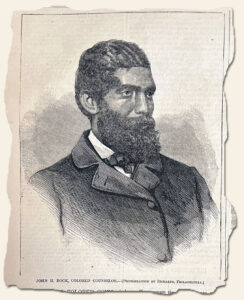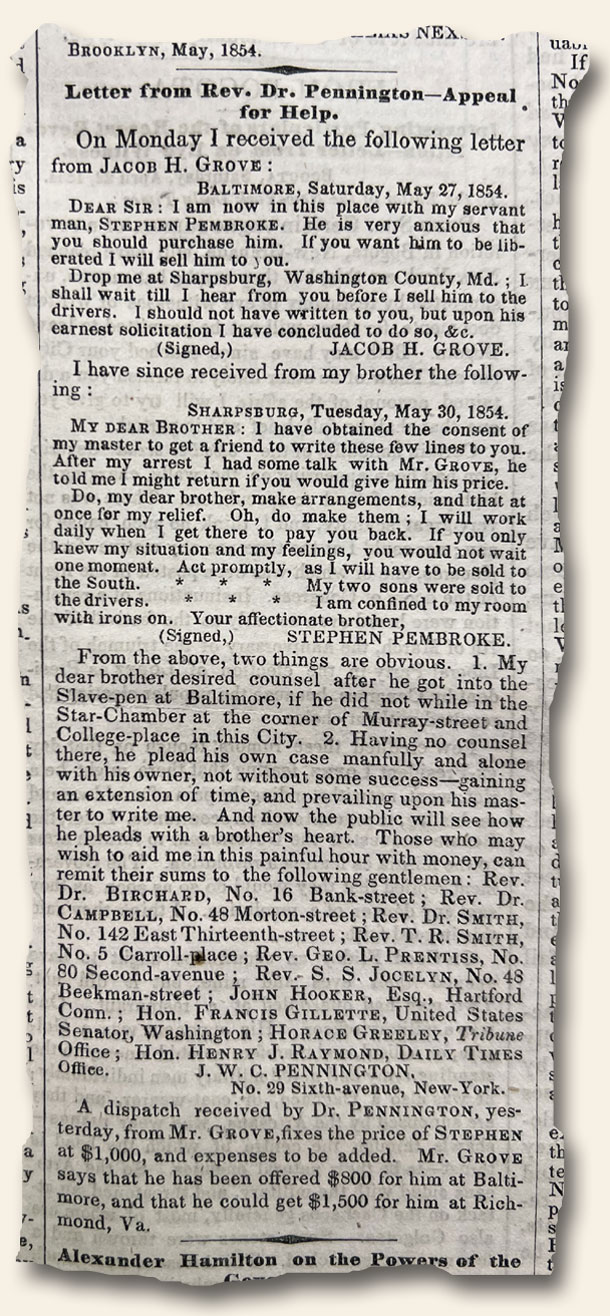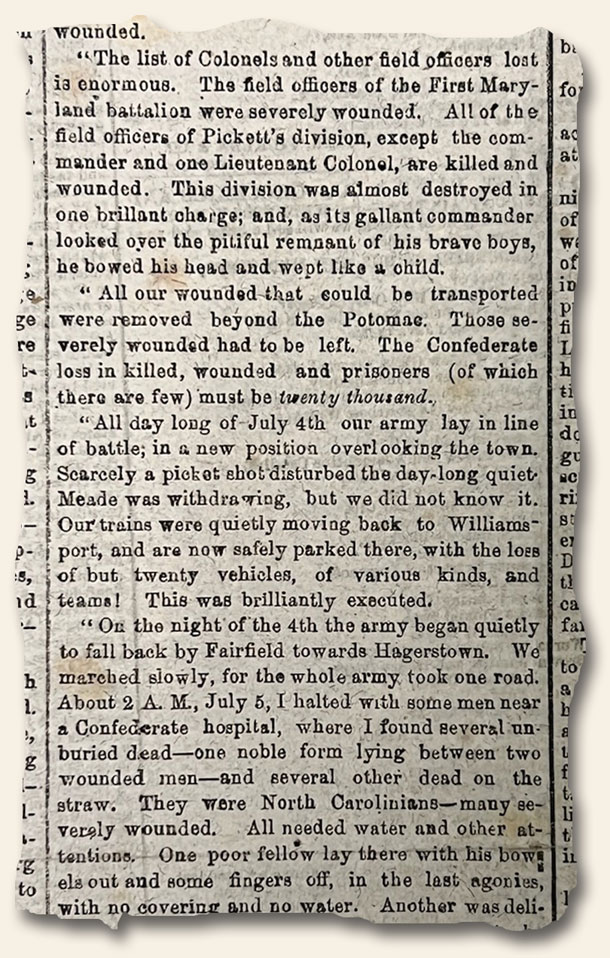Our obsession with “firsts”… History gives us plenty – including John Rock…
November 28, 2022 by Laura Heilenman · Leave a Comment
 We are a people enamored with firsts: our 1st kiss … finishing in 1st place… 1st to fly… 1st to discover “The New World” (still up for debate)… When I study Scripture, I love using something called “the law of first mention” which says, we best understand a particular word or doctrine by finding and then learning all about the first place in Scripture the word or doctrine was revealed. We also love the 1st man on the moon, the 1st rock opera – and the list goes on and on. Speaking of 1sts…
We are a people enamored with firsts: our 1st kiss … finishing in 1st place… 1st to fly… 1st to discover “The New World” (still up for debate)… When I study Scripture, I love using something called “the law of first mention” which says, we best understand a particular word or doctrine by finding and then learning all about the first place in Scripture the word or doctrine was revealed. We also love the 1st man on the moon, the 1st rock opera – and the list goes on and on. Speaking of 1sts…
On February 2, 1865, THE NEW YORK TIMES gave us another first to appreciate, and then later, on February 25, 1865, HARPER’S WEEKLY put a face on this first: that is, John Rock becoming the first African American attorney admitted to the bar of the U.S. Supreme Court. The New York Times stated in part: “J. S. Rock, of the Supreme Court of Massachusetts, was to-day, on motion of Senator Sumner, admitted an Attorney and Counsellor in the Supreme Court of the United States.” Quite historic!
Whether we are reading or collecting “early” newspapers, history provides us with a fascinating list of 1sts which can be celebrated and studied… 1st shut out in baseball… 1st Hispanic Supreme Court Justice… shall I go on?
Time-Lapse… Frederick Douglass (1834) to Henry Garnett (1865)…
November 24, 2022 by GuyHeilenman · Leave a Comment
As I continue to slowly devour every word of the autobiography, “The Life and Times of Frederick Douglass”, I was recently moved to as close to tears as I come as I pondered his retelling of the crushing hopelessness he felt after having been beaten to a whisper of death:
“I have often, in the deep stillness of a summer’s Sabbath, stood all alone upon the banks of that noble [Chesapeake] bay, and traced, with saddened heart and tearful eye, the countless number of sails moving off to the mighty ocean. The sight of these always affected me powerfully. My thoughts would compel utterance; and there, with no audience but the Almighty, I would pour out my soul’s complaint in my rude way with an apostrophe to the moving multitude of ships.”

‘You are loosed from your moorings, and free. I am fast in my chains, and am a slave! You move merrily before the gentle gale, and I sadly before the bloody whip. You are freedom’s swift-winged angels, that fly around the world; I am confined in bonds of iron. O, that I were free! O, that I were on one of your gallant decks, and under your protecting wing! Alas! betwixt me and you the turbid waters roll. Go on, go on; O, that I could also go! Could I but swim! If I could fly! O, why was I born a man, of whom to make a brute! The glad ship is gone: she hides in the dim distance. I am left in the hell of unending slavery. O, God, save me! God, deliver me! Let me be free!–Is there any God? Why am I a slave? I will run away. I will not stand it. Get caught or get clear, I’ll try it. I had as well die with ague as with fever. I have only one life to lose. I had as well be killed running as die standing. Only think of it: one hundred miles north, and I am free! Try it? Yes! God helping me, I will. It cannot be that I shall live and die a slave. I will take to the water. This very bay shall yet bear me into freedom. The steamboats steer in a northeast course from North Point; I will do the same; and when I get to the head of the bay, I will turn my canoe adrift, and walk straight through Delaware into Pennsylvania. When I get there, I shall not be required to have a pass: I will travel there without being disturbed. Let but the first opportunity offer, and come what will, I am off. Meanwhile I will try to bear the yoke. I am not the only slave in the world. Why should I fret? I can bear as much as any of them. Besides I am but a boy yet, and all boys are bound out to someone. It may be that my misery in slavery will only increase my happiness when I get free. There is a better day coming.’
I shall never be able to narrate half the mental experience through which it was my lot to pass, during my stay at Covey’s. I was completely wrecked, changed, and bewildered; goaded almost to madness at one time, and at another reconciling myself to my wretched condition.”
All bound by the common thread of having been given the breath of life by the same Creator, how could one “brother” treat a fellow sojourner with such abject cruelty? This goes beyond black and white as the relationship between slave an owner has played out similarly since the dawn of time, however, will it never end? Would ”The Almighty” hear his cry?
Fastforward approximately 30 years. Frederick Douglass is now free, residing in the North, and is living a life of gratitude expressed by his exhaustive efforts for the cause of abolition. Slaves are on the cusp of being emancipated, and for the first time in the history of the United States, a former slave of African descent, Rev. Henry Garnett, was permitted to preach (a common occurrence for whites) at The Capital. The article below regarding this event was printed in the New York Tribune, dated February 13, 1865. There would still be many obstacles to overcome before former slaves (or their descendants) would be viewed as “equal under the law”, and some might (rightfully) argue additional progress still needs to be made, but in this moment in time, with the Frederick Douglass quote fixed firmly in my mind and weighing heavy on my heart, I am grateful for the hope provided by the gains which have been made through time.

Help needed to understand – Rev. J.W.C. Pennington’s correspondence…
November 21, 2022 by GuyHeilenman · Leave a Comment
While reading the autobiography “The Life and Times of Frederick Douglass” a few days ago, at one point Douglass mentions his marriage to Anna Murray being presided over by Rev. J. W. C. Pennington, a “highly respected” pastor who was himself a former slave. To go from being a slave to a free, admired, New York City pastor certainly perked my interest. As is typical in the world of Rare & Early Newspapers, I immediately dug in to see if any newspapers mentioned this “highly respected” pastor. Thanks to the online database of The New York Times, I found an article in the NYT for June 2, 1854, which provided an exchange of letters between the pastor and two others in regard to the purchase of a slave. To be honest, after reading through the correspondence multiple times, my lack of knowledge of such things is currently winning the day. Is this related to the underground railroad? Was the potential “purchase” of this slave a means of emancipating him? If so, was this common? Although I am (slightly) embarrassed to admit it, I do not understand this exchange – but do not want to remain uninformed. If anyone can enlighten me, please email me at guy@rarenewspapers.com. If appropriate for the History’s Newsstand Blog, with permission I would like to add anything which might be helpful to readers of this post. Thanks in advance. The article:
A “Thankful” Heart Is Great Medicine… Happy Thanksgiving!
November 17, 2022 by GuyHeilenman · 2 Comments
A wise man was once inspired to pen: “A joyful heart is good medicine, but a broken spirit dries up the bones” (Solomon, Prov. 17:22). While many can attest to the wisdom and accuracy of this proverb, there is no doubt joy and gratitude are joined at the hip – or perhaps more appropriately said, at the heart. In this regard…
I have always been struck to the bone by reading about or seeing images of families, friends, and at times entire communities gathered together giving thanks to their Creator while enduring severe hardship. Many a President has issued Proclamations for a Day of Thanksgiving, Humiliation, and Prayer in the midst of war or soon after a severe calamity had befallen the nation. Yet, surrounded by what would appear to be great distress, somehow they were able to reach down into their innermost selves to find enough joy (not happiness or pleasure) to ignite thankful hearts. I don’t know about you, but such expressions of gratefulness are humbling, yet soothing to the soul.
The two rare Winslow Homer prints found side-by-side in the Frank Leslie’s Illustrated for Dec. 23, 1865 are shown below. In case their captions are too small to be easily read, they are: “Thanksgiving Day–Hanging Up the Musket” and “Thanksgiving Day–The Church Porch“. The Civil War had come to an end eight months prior and the guns of war (notice the dates) were being retired to their perches above the very place where Christmas stockings would soon be hung. What a relief to finally have the war at their backs! However, in case one might conclude its impact would soon dissolve into a distant memory, the corresponding illustration showing the gathering of the community for Thanksgiving worship reveals the fallout which would last a lifetime… for those who still had lifetimes to give. How they still found the strength to join together for the giving of thanks as a marvel.
That’s the kind of inner strength I want for my family and me. Perhaps you do as well. Perhaps it starts with regularly taking time to smell the roses while acknowledging the Source of the daily blessings which so often come our way. Happy Thanksgiving.


Note: JSTOR posted a related article featuring an excerpt by Christopher Kent Wilson which provides additional background regarding the Homer prints.
Separation of Church & State – Catholic concern in early 1800’s…
November 14, 2022 by Laura Heilenman · Leave a Comment
On April 23, 1804, The Order of Ursuline Nuns from New Orleans penned a letter to then President Thomas Jefferson. In their letter, they expressed concerns about their property being confiscated. The letter said in part: “they [those within the Order] cannot but be anxious to know that the property which is to enable them to fulfil these duties will be secure to them”. Just seven months later, Jefferson replied with the following:
“To the Soeur Therese de St. Xavier farjon Superior, and the Nuns of the order of St. Ursula at New Orleans:

I have received, holy sisters, the letter you have written me wherein you express anxiety for the property vested in your institution by the former governments of Louisiana. the principles of the constitution and government of the United States are a sure guarantee to you that it will be preserved to you sacred and inviolate, and that your institution will be permitted to govern itself according to its own voluntary rules, without interference from the civil authority. whatever diversity of shade may appear in the religious opinions of our fellow citizens, the charitable objects of your institution cannot be indifferent to any; and its furtherance of the wholesome purposes of society, by training up its younger members in the way they should go, cannot fail to ensure it the patronage of the government it is under. be assured it will meet all the protection which my office can give it.
I salute you, holy sisters, with friendship & respect.
Th: Jefferson”
The POLITICAL OBSERVATORY, November 17, 1804, carried the entire letter with Jefferson’s signature.
Ironically, within the next 30 years, a very different story was recorded. The October 11, 1834, NILES’ WEEKLY REGISTER, had multiple pages of coverage of the August 11 and 12, 1834 Ursuline Convent riots in Charlestown, Massachusetts.
Wiki states these riots were, “fueled by the rebirth of extreme anti-Catholic sentiment in antebellum New England.”
Perhaps the Nuns of 1804 had a prophetic gift enabling them to foresee troubles to come.
Veterans – War’s end is rarely met with the end to their battles…
November 10, 2022 by GuyHeilenman · Leave a Comment
Once the battle is over and the smoke has cleared, the life of a veteran has not always been rosy and gay. Quality healthcare, needed family benefits, receipt of back pay, sufficient re-entry counselling, quality care for wounded warriors, ongoing honor for their service, etc. have often been less than desirable, and far below the need. This isn’t to say strides over time have not been made, but like many societal issues, much work still needs to be done.
One step in the right direction took place in 1942 and was reported in The New York Times for June 23rd. It told of FDR signing the G.I. Bill of Rights and was accompanied by a nice photo of the signing.
Thankfully, the trek did not end here and continues to this day. The following link will take you to a chronological journey through issues with content related to veterans (you may need to select the individual issue’s link to see/read the content):
The Battle of Gettysburg… an intimate look…
November 7, 2022 by Laura Heilenman · Leave a Comment
I would imagine, as a journalist, an eyewitness is the “rare pearl”. Research is all well and good but interviewing someone who saw it with their own two eyes will most often give the very best information. So it was for the journalist who wrote for the DAILY RICHMOND EXAMINER, July 17, 1863 issue. The article…
“The Invasion of Pennsylvania–The Battle Of Gettysburg–The Retreat To Hagerstown” features an eye-witness account of the retreat and is prefaced with: “…the only connected, intelligent and intelligible account that has yet been given to the public of the movements of General Lee…after the Battle of Gettysburg.” This lengthy & detailed accounting by one of the soldiers begins with the Confederate advance from Virginia into Maryland on June 18, then continues with: “On Friday, 26th, we took up the line of march through Chambersburg on the Harrisburg road. The splendid band in the 4th Louisiana brigade…proceeded the column playing ‘Dixie” and the Marseillaise…We passed through Shippensburg to the sound of martial music again & went on to Carlisle…Harrisburg was in a panic…”.
A report from a soldier who was more than an eyewitness of the battle; rather, one who experienced it first-hand… From a journalist’s point of view, it just doesn’t get any better. 
It’s All About the Headline…
November 5, 2022 by Laura Heilenman · Leave a Comment
Some of our collectors are drawn to a poignant political speech and some are passionate about 17th – 19th century maps. More than a few seek reports of famous battles while others can’t resist death reports of notable generals. When it comes to the Rare & Early Newspapers collectible, breadth of interest runs from the heart-wrenching past (illustrated slave ads – lest we forget), to the lighthearted (a recent issue containing an ad & review of a favorite movie. However, regardless of their interest, for a majority of collectors it’s all about the headline – the more frameable and dramatic, the better!
 With this in mind, may I submit as an example the banner headline of Hearst’s Boston American for April 23, 1906: “SAN FRANCISCO SUFFERERS GO MAD! “, followed by: “Crazed By Horrors They Roam The Streets”. Can we all agree… even the tabloids of today can’t touch this! So, whether you are drawn to the macabre, the triumphant, or merely the historical, for many it’s all about the headline. After all…
With this in mind, may I submit as an example the banner headline of Hearst’s Boston American for April 23, 1906: “SAN FRANCISCO SUFFERERS GO MAD! “, followed by: “Crazed By Horrors They Roam The Streets”. Can we all agree… even the tabloids of today can’t touch this! So, whether you are drawn to the macabre, the triumphant, or merely the historical, for many it’s all about the headline. After all…
GREAT HEADLINES SPEAK FOR THEMSELVES
Exploring an Introductory Lot of Ten 19th Century Newspapers…
November 4, 2022 by GuyHeilenman · Leave a Comment
What can one find in the Introductory Lot of 10 issues from the 1800s offered at RareNewspapers.com – especially considering the cost is under $30?
To explore this from the perspective of a novice we asked the newest member of our staff, who knew absolutely nothing about “rare & early” newspapers prior to joining our family, to select a random set and start digging through the set. To make the “exploration” as honest an endeavor as possible we asked her to video herself as she explored. Not polished, a bit rough, unrehearsed… but in our opinion the video provides a fresh look at how a young adult who is new to the collectible might react to receiving such a lot. If you have ever purchased this lot, feel free to share your “finds”.


